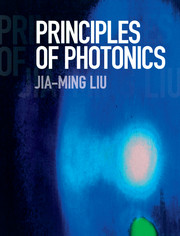Book contents
- Frontmatter
- Dedication
- Contents
- Preface
- Partial List of Symbols
- 1 Basic Concepts of Optical Fields
- 2 Optical Properties of Materials
- 3 Optical Wave Propagation
- 4 Optical Coupling
- 5 Optical Interference
- 6 Optical Resonance
- 7 Optical Absorption and Emission
- 8 Optical Amplification
- 9 Laser Oscillation
- 10 Optical Modulation
- 11 Photodetection
- Appendix A Symbols and Notations
- Appendix B SI Metric System
- Appendix C Fundamental Physical Constants
- Appendix D Fourier-Transform Relations
- Index
- References
8 - Optical Amplification
Published online by Cambridge University Press: 05 August 2016
- Frontmatter
- Dedication
- Contents
- Preface
- Partial List of Symbols
- 1 Basic Concepts of Optical Fields
- 2 Optical Properties of Materials
- 3 Optical Wave Propagation
- 4 Optical Coupling
- 5 Optical Interference
- 6 Optical Resonance
- 7 Optical Absorption and Emission
- 8 Optical Amplification
- 9 Laser Oscillation
- 10 Optical Modulation
- 11 Photodetection
- Appendix A Symbols and Notations
- Appendix B SI Metric System
- Appendix C Fundamental Physical Constants
- Appendix D Fourier-Transform Relations
- Index
- References
Summary
POPULATION RATE EQUATIONS
From the discussion in the preceding chapter, it is clear that population inversion is the basic condition for an optical gain. For any system in its normal state in thermal equilibrium, a low-energy level is always more populated than a high-energy level, hence there is no population inversion. Population inversion in a system can only be accomplished through a process called pumping by actively exciting the atoms in a low-energy level to a high-energy level. If left alone, the atoms in a system relax to thermal equilibrium. Therefore, population inversion is a nonequilibrium state that cannot be sustained without active pumping. To keep a constant optical gain, continuous pumping is required to maintain population inversion. This condition is clearly consistent with the law of conservation of energy: amplification of an optical wave leads to an increase in optical energy, which is possible only if the required energy is supplied by a source.
Pumping is the process that supplies energy to the gain medium for the amplification of an optical wave. There are many different pumping techniques, including optical excitation, electric current injection, electric discharge, chemical reaction, and excitation with particle beams. The use of a specific pumping technique depends on the properties of the gain medium being pumped. The lasers and optical amplifiers of particular interest in photonic systems are made of either dielectric solid-state media doped with active ions, such as Nd:YAG and Er:glass fiber, or direct-gap semiconductors, such as GaAs and InP. For a dielectric gain medium, the most commonly used pumping technique is optical pumping using either an incoherent light source, such as a flashlamp or a light-emitting diode, or a coherent light source from another laser. A semiconductor gain medium can also be optically pumped, but it is usually pumped by electric current injection. In this section, we consider the general conditions for pumping to achieve population inversion. Detailed pumping mechanisms and physical setups are not addressed here because they depend on the specific gain medium used in a particular application.
The net rate of increase of the population density in a given energy level is described by a rate equation. As we shall see below, pumping for population inversion in any practical gain medium always requires the participation of more than two energy levels.
- Type
- Chapter
- Information
- Principles of Photonics , pp. 249 - 273Publisher: Cambridge University PressPrint publication year: 2016

